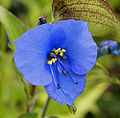Dayflower
| Dayflower |
|---|

|
| Scientific Classification |
|
| Species |
|
Dayflower is the common name for several species of flowers that belong to the taxonomic genus Commelina. Its elegant flowers usually have bright blue petals and three big stamen. It is one to two inches long with leaves that are five inches long and two inches across.
Anatomy
The dayflower is one to two inches long. It either crawls along the ground or grows up onto or around things. Its stems are long, completely smooth, and have no hair on them. Their leaves are alternate and are five inches long and two inches across. They are either oval or heart-shaped. Margins of the dayflower are smooth and the veins run parallel to each other. The base of each leaf clasps to whatever it touches; it is sessile. It has a membranous sheath that wraps around the stem. This sheath grows to about one inch long and it has green, longitudinal veins; otherwise, it is white or white with a tint of green. On the upper edge of the sheath, there is no hair, but for a few uncommon species, there are some fine, upright hairs.
Only every once in a while is a tiny flower, about one to two inches long, is produced by the leaf axils. The leaf can be one half to one inch long, which has two small, blue petals on it, one small white petal, three sepals, five to six stamens, and a lengthy white style. The sepals can be transparent or pale white. The upper stamens have bright and colorful, yellow anthers. These help the flower attract insects. Although the anthers are less flashy, the lower stamens are longer than the upper stamens; they're fertile. There is a spathe that is about one half inch long and green. It is upturned and lies underneath the flower. The upper parts of this spathe are free all the way to the base. In mid-summer to early fall, the blooming period takes place and lasts about one to two months. Each flower blooms only in the morning for one day, which is why this flower is known as the dayflower. There isn't a noticeable scent. A seed capsule that has 2 cells, replaces each flower; each cell contains 2 seeds. These seeds have a rough and bumpy surface and are dark brown or black. It has a fibrous root system. This plant is capable of rooting and the plant nodes if places in moist ground, forming new plants vegetatively. If the site is favorable, the Asiatic dayflower can take over other plants.[1]
Reproduction
When you look at the dayflower from above you will see the mouse-ear petals. In addition to that, there is a confusing abundance of reproductive parts on a blossom, which is only about an square inch wide. There are three sterile stamens (the top three yellow structures), three fertile stamens (the bottom yellow structure and two kind of side curved structures with flattened brownish ovals). The fertile stamens produce pollen, which gets transported by bees, to the head of the closest flower's pistil (the rest of the flower that has a small, pinkish tip). When a pollen grain is put into the end of a pistil, it slowly migrates down into the ovary and fertilizes the egg. Once the embryo is in the ovule, it grows very quickly. In each ovule, one or two granular, eighth-inch, reddish seeds grow; usually they germinate the following year after they sit dormant in the soil. The dayflower is an annual plant so regular re-seeding is essential for survival. [2]
Ecology
The dayflower lives in dry, open areas.[3] It also may live in moist, sandy soils. [4]
Bengal dayflower vs Cotton
The Bengal dayflower (also known as tropical spiderwort) is becoming an important species in Africa and Asia, not to mention, in irrigated fields. According to the US Federal Noxious Weed List, Bengal dayflower has become a big part in crop production in Southeast U.S. In the Coastal Plain of the Southeast US, soils are typically coarse textured, limited water-holding ability, and have small amounts of organic substance. In order to evaluate the relationship between soil moisture and growth rate of Bengal dayflower in comparison with cotton and to determine how reproduction through aerial and subterranean seed production is affected, studies were instigated. Bengal dayflower had 3.5 times more above ground biomass than cotton did. Towards the end of the study, there was a different linear relationship between the above ground biomass and duration of drought stress for cotton and Bengal dayflower, with a more intense rate of reduction for Bengal dayflower than for cotton. Irrigation regimes may be instigated to control the Bengal dayflower, which supplies only enough water for the cotton, then the excess water will be used by Bengal dayflower. [5]
Gallery
References
- Asiatic Dayflower Weedy Wildflowers of Illinois
- Asiatic Dayflower Bill Hilton Jr., Hilton Pond Center
- Dayflower Wildflowers of Southern U.S.
- Commelina diffusa Burm. - Day Flower
- Weed Research Theodore Webster, USDA, 06/01/2009




